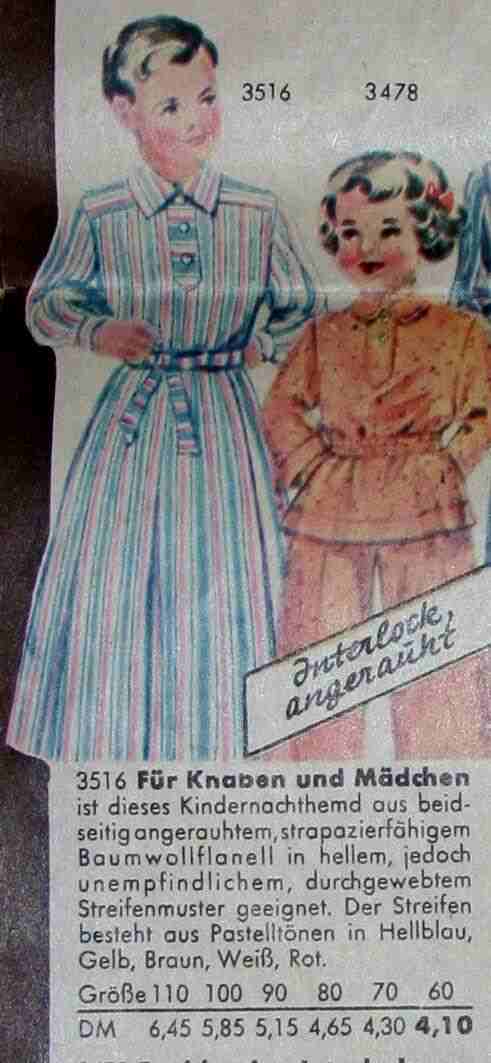
Unknown Nightshirt (Germany, 1953)

Figure 1.-- We note a 1953 German catalog with a page on sleepwear. Before World War II, we believe that nightshirts were more common than pajamas. After the War by the 1950s, pajamas had becone more common, but nightsirts were still worn. We are not sure what catalog it is from.
|
|
We note a 1953 German catalog with a page on sleepwear. Before World War II, we believe that nightshirts were more common than pajamas. After the War by the 1950s, pajamas had becone more common, but nightsirts were still worn. We are not sure what catalog it is from or when it was issued in 1953, but it apparently is a cold weather garment. Flannel was a popular fabric for winter sleepwear. This garment, however, is cotton flannel. One of the items is for a nightshirt. The illustration pictures a boy wearing it, but the ad copy explains that it was for both boys and girls. They were made in sizes (Größe) 60-110, presumably centimeters. I would guess that this is the length of the garment. I'm not sure of the age conversion.
Catalog
We note a 1953 German catalog page on sleepwear. We are not sure what catalog it is from.
Chronology
We do know that the catalog was issued in 1953, but we do not know when it was issued. It looks like a cold weather garment to us.
Nightshirts in Germany
Before World War II, we believe that nightshirts were more common than pajamas. After the War by the 1950s, pajamas had becone more common, but nightsirts were still worn.
Fabric
Flannel was a popular fabric for winter sleepwear. This garment, however, is cotton flannel. True flannel is a wool fabric, but a cheaper fabric with some similarity to flannel was made with cotton. The German word for cotton is interesting--Baumwol. That litterally meand tree wool. It probably reflects the fact that cotton was little known in Europe during the Middleages when the German language developed. Thus the Germans made up a word based on the more familiar wool material.
Item
One of the items on the sleepwear page was a nightshirt. The illustration pictures a boy wearing it, but the ad copy explains that it was for both boys and girls. They were made in sizes (Größe) 60-110, presumably centimeters. I would guess that this is the length of the garment. I'm not sure of the age conversion.
Ad Copy
The ad copy reads, "3516 Für Knaben und Mädchen ist dieses KIndernachthemd aus beidseitgngerauhtem, stropazierfähigem Baumwollflanell in hellem, jedoch unempfindlichem, durchgewebtem Striifenmuster geeignet. Der Striifen besteht aus PastelltÖnen in Hellblau, Gelb, Braun, Weiss, Rot." This translates as, "For boys and girls, this children's nightshirt, roughened on both sides, of hardwearing cotton flannel is suitable in a bright, although durable, interwoven, striped pattern. The stripes consist of pastel tones in light-blue, yellow, brown, white, red."
Interlock, angeraüht
There is also a insert reading, "Interlock, angeraüht". I'm not sure what that means, although "angeraüht" means "roughened". A reader writes, "Interlocking is an embroidery term. It is quite hard to explain what it is
in plain English but if you think of a boy scout badge there is a binding
stitch around the edge - that is interlocking. The technique also permits
stitching to take place on both sides of a piece of fabric. On the PJs you
refer to I would presume they are talking about the way they have sewn the
seams but I don't know what the 'roughened' bit would refer to unless its
some term to describe how they have done away with rough or coarse seams."
AFrench reader tells us, "Interlock in German and French is not a embroidery term but a sort of fabric with the particularity to be quite flexible. This fabric is widely used for baby clothes and underwear. "Beideseitig angerauhtem" simply means that the both surfaces of this fabric is smooth in woolly style like the Pilou material."
Pajamas
Also pictured is pajamas with a girl model. I'm not sure if they were also for both genders. The look more like girls Chinese styled pajamas.
Reader Comments
A British reader writes, "First time I've ever seen a nightshirt worn with a belt or
multi-coloured/pattern. All I've seen in photos or films have been fairly plain and either white or cream coloured."
HBC

Navigate the Boys' Historical Clothing catalog/magazine pages:
[Return to the Main German 1953 catalog page]
[Return to the Main German 1950s catalog page]
[Main photo/publishing page]
[Store catalogs]
[Fashion magazines]
Navigate the Boys' Historical Clothing Web Site:
[Introduction]
[Activities]
[Biographies]
[Chronology]
[Clothing styles]
[Countries]
[Topics]
[Bibliographies]
[Contributions]
[FAQs]
[Glossaries]
[Satellite sites]
[Tools]
[Boys' Clothing Home]
Navigate the Boys' Historical Clothing Web Site:
[Sailor suits]
[Sailor hats]
[Short pants suits]
[Long pants suits]
[Eton suits]
[Rompers]
[Smocks]
[Short pants]
[Lederhosen]
[Kneesocks]
[Long stockings]
[Tights]
[Leibchen]
[Sleepwear]
Created: 3:55 PM 4/6/2007
Last updated: 12:19 AM 4/7/2007



